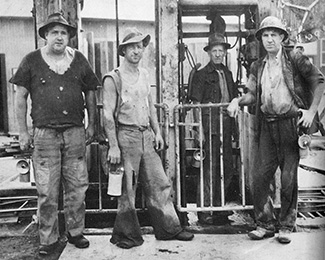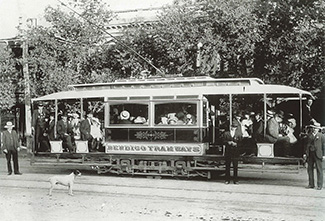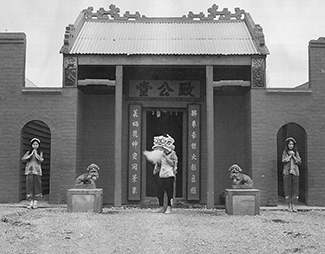Central Deborah Gold Mine
 Central Deborah Gold Mine operated from 1939-1954 and during that time employed 357 male miners who successfully extracted almost one ton of gold (929kg) from the ground, worth about $50 million at today's prices.
Central Deborah Gold Mine operated from 1939-1954 and during that time employed 357 male miners who successfully extracted almost one ton of gold (929kg) from the ground, worth about $50 million at today's prices.
At its peak, Central Deborah Gold Mine reached a depth of 412 metres. It has 17 separate levels and 15 kilometres of drives and cross cuts (tunnels).
The Central Deborah was very much a hands-on mine and the conditions that the miners worked in would be considered shocking by today's standards – being lowered underground in a cage with only two sides, often working ankle to knee deep in water, filling up to 32 ore trucks a shift by hand which were then pushed a mile or more along rails in the drives, working by carbide lamp, breathing in the fumes and rock dust and communication by bells.
Geez, they were ironmen. However, at the time working conditions were considered to be among the best on the goldfields at Central Deborah, after all it was one of the only mines that had hot showers.
Following Central Deborah Gold Mine's closure, the Bendigo skyline began to noticeably change. Obvious remnants of mining such as poppet heads, engine rooms, service quarters, battery houses and chimneys were steadily disappearing.
After intense lobbying by the local community, the Bendigo City Council purchased the still very much intact Central Deborah Gold Mine in 1970 for a mere $6,000 to ensure that a vital link to Bendigo's historic golden past was maintained.
Today, Central Deborah Gold Mine is an award winning tourist attraction. A key to our success has been maintaining the authenticity of the site.
Click here for more information about Central Deborah Gold Mine’s fascinating history.
Bendigo Tramways
 Bendigo Tramways has been in operation since June 1890. From that time, the citizens of Bendigo have experienced battery, steam and electric traction as the principal modes of propulsion for their trams.
Bendigo Tramways has been in operation since June 1890. From that time, the citizens of Bendigo have experienced battery, steam and electric traction as the principal modes of propulsion for their trams.
The outbreak of World War II was a testing time. Revenue and passenger numbers were declining as automobiles became more popular. Additionally, shortages in manpower and materials due to wartime economies caused difficulties.
As a result, the SEC made several attempts at closing the tramways and handing over the passenger services to private bus operators. It took some time, but in July 1970 the Victorian Parliament finally granted the SEC's application for abandonment of the tramways.
Despite the seeming practicality of a shift to private buses, the idea of trams vanishing from Bendigo's streets did not sit easily with the community. Many felt that the legacy of the past was being squandered, and the newly formed Bendigo Trust was called upon to present a submission to the Bendigo City Council suggesting that a two year trial for a tourist tramway be undertaken.
The Bendigo Trust's persistence was rewarded in September 1972 when the Victorian Cabinet announced that it had approved the two year trial.
No other Australian city which closed its tramway system left track, trams and a depot behind in the manner that Bendigo did and this enables us to create a picture of the past for our visitors. Whether enjoying a Vintage 'Talking' Tram Tour or taking our guided Depot and Workshop tour, a visit to Bendigo Tramways drives home the significance of how Bendigo has developed as a city, and the role Bendigo Tramways has played in that development.
Today, Bendigo Tramways is Australasia's largest tourist tramway and welcomes over 40,000 visitors annually. The Bendigo Tramways Depot is the oldest operating tram depot in Australia and is listed on the Victorian Heritage Register. We currently have 45 trams in our fleet (13 of which operate as part of the 'Talking' Tram service).
Click here for more information about Bendigo Tramway’s fascinating history.
Bendigo Joss House Temple
 From when gold was first discovered in 1851 to the present day, the Chinese community has been a part of the proud history of Bendigo.
From when gold was first discovered in 1851 to the present day, the Chinese community has been a part of the proud history of Bendigo.
The Bendigo Joss House Temple, a Chinese house of prayer, was constructed in the 1870s. Standing for over a century, the Bendigo Joss House Temple is one of the few remaining buildings of its type in Australia.
Constructed with locally hand-made bricks and painted red, symbolising the traditional Chinese colour denoting strength and vitality, the Bendigo Joss House Temple provides a glimpse into Chinese culture and tradition.
The main temple is dedicated to Guan Di, the god of war and prosperity. The Chinese saw him as a wise judge, guide, protector and provider of wealth and prosperity; attributes sought by the Chinese inhabitants of this strange land.
The Bendigo Joss House Temple has been managed by Bendigo Heritage Attractions since 2007.
Click here for more information about the Bendigo Joss House Temples fascinating history.
Some interesting facts ...
- The first tour of the Central Deborah Gold Mine surface precinct was conducted on Good Friday in 1971 and tickets were just 20¢.
- In 1971 The Bendigo Trust established an afforestation committee with a brief to promote tree planting in and around Bendigo. This committee functioned until 1980, with 2,700 trees planted during 1977/78 alone.
- The Bendigo Trust opened the city’s first Tourist Information Centres, at Charing Cross and Kangaroo Flat in 1974.
- The Bendigo Trust opened the Dai Gum San Wax Museum in 1975 with 60 wax figures donated by Vivian Sun.
- From 1981 – 1986 The Bendigo Trust ran tours of Fortuna Villa.
- 1993 saw the commencement of Double Decker Bus Tours which operated for 10 years.
- In 1995 the first public tours of the Bendigo Gas Works were carried out on weekends and holidays.
- The Bendigo Trust managed the Discovery Science & Technology Centre from 2001 – 2015.
- The Bendigo Trust took over the management of the Bendigo Joss House Temple from the National Trust in 2007.
- On 16 October 2010, The Bendigo Trust overtook the State Electricity Commission of Victoria as Bendigo’s longest serving tram operator.




 Copyright © 2016 Bendigo Heritage Attractions. All rights reserved.
Copyright © 2016 Bendigo Heritage Attractions. All rights reserved. 